It takes very little research to find many a mention of John Wolf throughout hot rodding’s history. He made a name while racing under the So-Cal Speed Shop banner and that thread leads to an interesting history of yet another hot rod hero.
John was born January 25, 1931, to Paul and Alma Wolf in Hollywood, California, where the family owned a grocery store at Cherokee and Sunset Boulevard. Back then, Hollywood was still Hollywood and there were plenty of nice cars on the streets to influence a young man. John’s first car was actually a first engine—a ’34 Ford flathead V-8 that at age 14 he stripped, rebuilt and installed in Harold Mason’s ’32 five-window. They took it out to Rosamond in 1947 for a Russetta meet but because they were under age and didn’t belong to any club they ran under the name of Bill Yates, a member of the Gazelles. There’s a great action shot of the car in Don Montgomery’s book Hot Rods in the Forties as well as a shot of the Gazelles around the car in Montgomery’s Authentic Hot Rods. The caption says the engine had Arco heads, Weiand intake, a Winfield cam and Mal Ord ignition and went 101 mph. Yates later ran a ’40 Ford Coupe with Ray Brown Automotive and the number 17 painted on the door—he worked for Ray. In 1950, Yates ran 129.78 mph.
Originally, Wolf was a member of the Crotch Cannibals before joining the Glendale Coupe & Roadster Club (GCRC), the number one Russetta club in 1948. In 1949, Wolf was racing the Class B ’40 Ford Coupe that he drove to school and El Mirage where he clocked 121 mph. He had two engines: a full-race, de-stroked, 249 ci Merc’ with Winfield cam, Evans heads, and an Ord intake with two Strombergs. The school engine was a mild ’41 Merc. In a memoir recorded by Michelle M. Yiatras, Wolf remembers, “Friday night put in the race engine, and Sunday night worked like hell to get the street engine in for school. Every weekend like that.” There’s a nice photo of Wolf and his bride to be, Virginia, in Don Montgomery’s book Authentic Hot Rods.
Eventually, in 1950, Wolf joined the Sidewinders with Alex Xydias—remember it was a race to win points—and purchased the first of several ’36 three-windows saying, “Smaller and more aerodynamic than the ’40, or even the ’32.” He paid just $15 for it. Unchopped, and painted blue it ran in the coupe and sedan class. Wolf is listed in the Russetta results in the November 1951 issue of Hop Up from a meet earlier that year when he ran 130.43 mph for a new Class B Coupe record. At the time, the GCRC were number two in points just behind the Rod Riders. The fun was about to end though.
In January 1952, Wolf was drafted into the Army where he was assigned to San Marcos, Texas, working on aircraft and helicopters. In his memoir he said, “I ran the Magnaflux and Zyglo processes in the parts shop 25 miles behind the front lines in Incheon the South Korean airport west of Seoul.” After two years he was discharged in time for Christmas 1953. Then it was back to the track.
Sadly, while he’d been away his friends Buddy Fox and Tom Cobbs took the ’36 to El Mirage where they crashed and destroyed it. Another ’36 was found. Gutted and lightened it ran first with a flattie but later with a Dodge Hemi. Painted red, it eventually sported a So-Cal-style white scallop on the nose and ran the drag strips from Saugus down to Paradise Mesa. Sometimes with a Jimmy 4-71 and two carbs, Wolf ran the car until about 1960.
Bonneville was on the horizon though and in 1958 Wolf had been talking to Mal Hooper about running his streamliner, the Shadoff Special, that Hopper co-owned with Ray Brown. The ’liner had debuted in 1953 when it set six international records enabling Hooper to became one of the first members of The 200 MPH Club. Unused, the Shadoff Special was loaned to Wolf and Bob Bowen who rebuilt and drove the car—Bowen having driven it in 1954. With sponsorship from Bill Shadoff’s Pomona-based Chrysler-Plymouth dealership as well as Chrysler and Firestone, the team set a number of records: The Class C Streamliner record in 1959 at 251.74 and an FIA Class C Streamliner record in 1960 at 252.22 mph. Bowen said of the 258 ci Dodge-powered car, “It had a two-speed transmission, with a two-speed rear end, and that became a three-speed operation. First shift in second gear transmission, then in the meantime shift the rear end into the higher gear ratio. It’s two shifts to have to pay attention to at 100 mph.”
After the Bonneville experience, Wolf quit auto racing and drifted into boat racing. In his interview with Michelle M. Yiatras he said, “I started boat racing in the early 1960’s. I quit car racing completely and boat raced until about 1979. My five liter hydroplane with a 302 ci Ford engine, ‘The Going Thing’, world record I set in 1971 in Parker AZ, still stands 152.13 mph 1 kilometer straightaway run, Union Internationale Motonautique, with a top one-way speed mark of 156.104 mph.” Wolf also worked on boats for Bud Meyer.
Despite two decades playing on water, Wolf hankered to return to Bonneville and in 1991 fielded a modified ’27 T roadster, named ‘880 SO-CAL’. It was powered by a turbocharged 258 ci small-block Ford with Hilborn injection, and attained four Bonneville records including the E/Blown Fuel Modified Roadster record at 265.970 mph in 1994. Meanwhile, on his licensing run, So-Cal founder Alex Xydias hit a speed of 176 mph—not bad for a 75-year-old. Wolf then sold the car, less engine—just in case.
By Tony Thacker
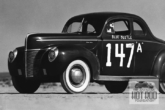
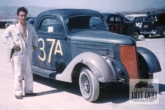
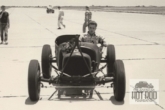
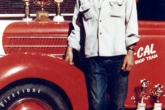

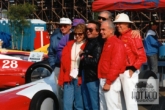
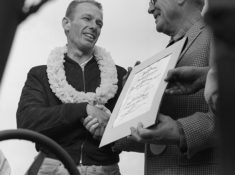 Jim Nelson
Jim Nelson Alex Xydias
Alex Xydias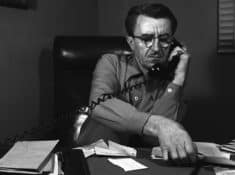 Eddie Edmunds
Eddie Edmunds Jack Calori
Jack Calori

